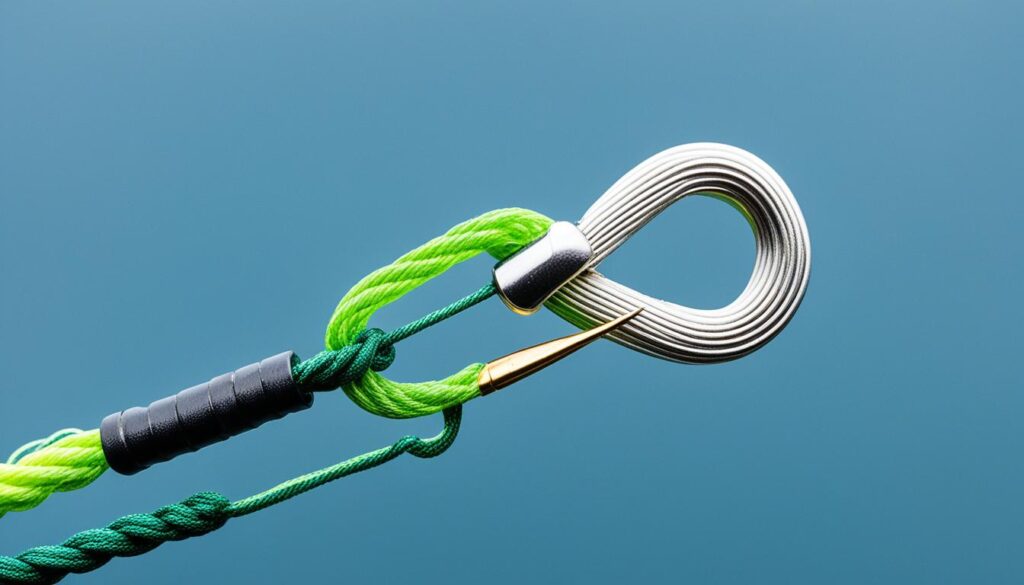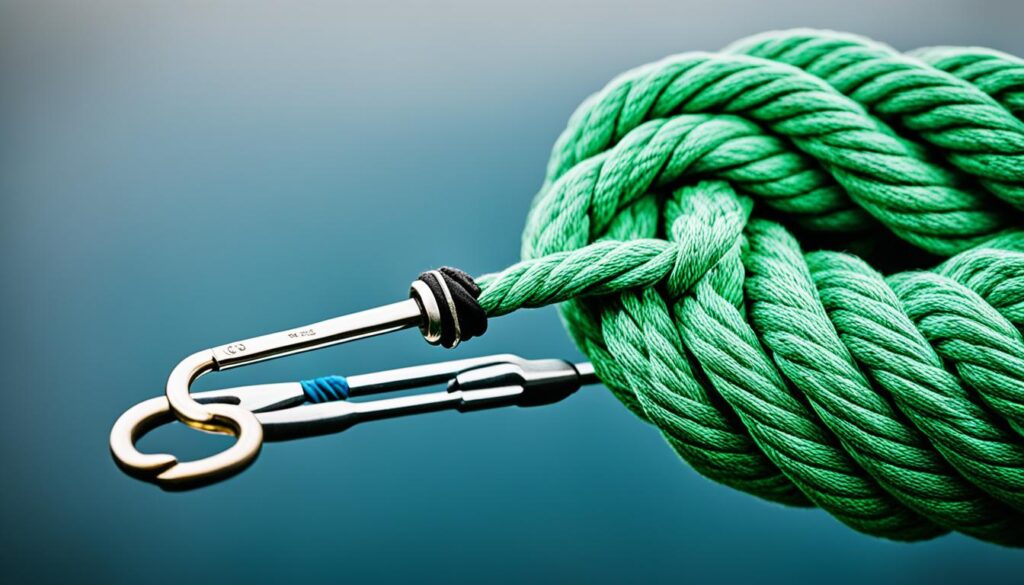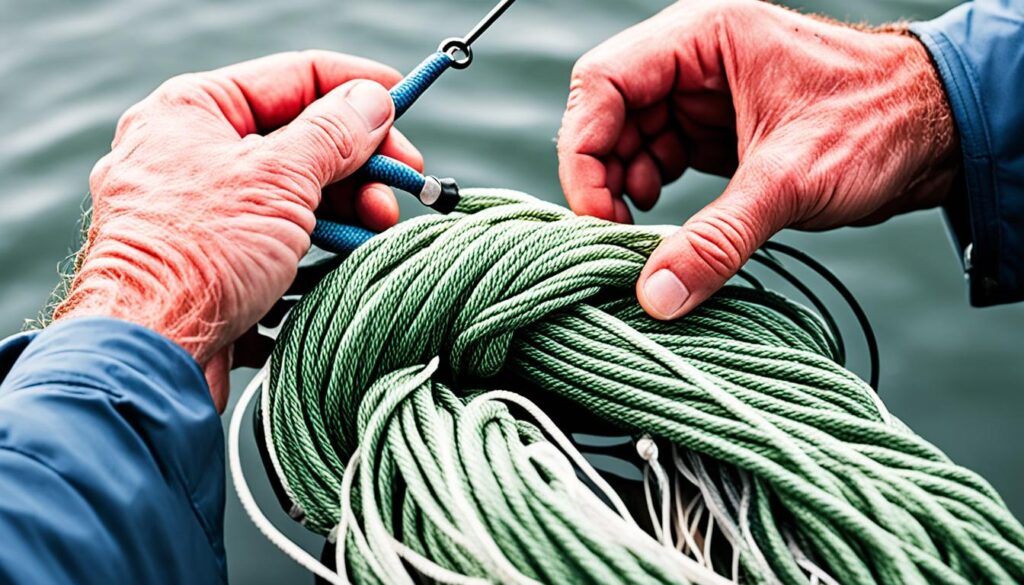Welcome to our guide on tying the Snell Knot! If you love fishing, you know using a strong knot is key. The Snell Knot keeps your hook tied tight to your line. This helps keep your catches from getting away.
Now, let’s learn how to tie the Snell Knot together. It’s easy once you get the hang of it. Just follow our steps carefully and practice a bit.
What is a Snell Knot?
A Snell Knot is used to attach a hook to a fishing line. Anglers love it for its strength. It makes sure the line stays strong. This knot wraps the line around the hook’s shank first. Then, it goes through the eye. This creates a strong link able to hold the fish’s weight.
Tying a Snell Knot requires tight wrapping around the hook’s shank. This makes the connection secure and reduces the likelihood of slipping. The knot spreads pressure evenly, strengthening the line and making it hard to break. It also improves how well the hook gets into the fish, reducing the risk of the hoo chances of it coming out.
The Snell Knot keeps the line strong, unlike other knots that cause wear. Wrapping the line around the hook’s shank protects it, making the knot great for big fish fishing. It prevents the line from weakening or fraying.
The Snell Knot’s direct hook-to-line connection makes bait look natural underwater, which is great for attracting fish. Anglers who care about how their bait looks and moves prefer this knot, which increases their chance of catching fish.
The Snell Knot is reliable for solid and durable connections. It’s perfect for live bait, big fish, and controlling bait movement. Many anglers trust this knot for different fishing needs.
Benefits of the Snell Knot
The Snell Knot is excellent for fishing. It is very strong and can hold heavy fish easily. This means it’s perfect for catching big fish. It also connects the hook directly to the line, which makes catching fish fast and secure.
This knot also stops the line from getting tangled. When casting, it makes everything smoother. Plus, the way it sets the bait makes it look natural. This natural look attracts fish more, which boosts your chances of a good catch.
Overall, the Snell Knot is good for all kinds of fishing. Its strength makes it great for big fish. Its direct hook-up and bait presentation feature make it a top pick for anglers wanting to catch fish more easily.
Additional Benefits
- Enhanced casting accuracy and control.
- Reduced line twist and tangles for a hassle-free fishing experience.
- Increased confidence in landing larger, trophy-worthy fish.
- Improved sensitivity for better detection of bites and strikes.
- Compatible with various fishing techniques, including bait fishing, casting, and trolling.
The Snell Knot’s direct hook-up offers anglers an advantage in quickly and securely connecting with fish. It eliminates the need for the fish to swallow the bait fully, resulting in more efficient hook sets and increased catch rates.

Disadvantages of the Snell Knot
The Snell Knot has many good points, but knowing where it falls short is vital. Learning the cons of this knot helps you know when it’s the right choice.
1. Complexity:
Making a Snell Knot is harder and takes more time, especially if you’re just starting out. It involves many steps that need to be just right, and it takes practice to get it perfectly.
2. Rigidity:
This knot is very stiff, which can be problematic in some fishing situations. It might be better for delicate fishing or with small hooks and lines. The lack of hook movement can make the bait look less natural, possibly scaring off cautious fish.
3. Potential Damage to the Fishing Line:
When tying a Snell Knot, you must be careful not to pull too hard on the line. Doing it wrong can harm the line, making it weaker. Could you make sure to tie it gently to keep your line strong?
4. Knot Strength:
Although the Snell Knot can bear a lot of tension, it may not hold as well over time compared to other knots. It could come undone, leading to a lost fish. You can always check and redo your knots as needed to keep them secure.

Best Time to Use a Snell Knot
The Snell Knot is perfect for specific fishing situations. Knowing when to use it will improve your fishing and increase your chances of catching fish.
For live bait fishing, use the Snell Knot. It’s great for worms, minnows, or any live bait. This knot keeps your bait secure. It also helps lure the fish closer. With the Snell Knot, your bait will stay on the hook, and you can cast far without worry.
| Fishing Technique | Benefits of Snell Knot |
|---|---|
| Live Bait Fishing | Secure attachment of live bait, increased casting distance, improved bait presentation |
| Bottom Fishing | Strong connection between hook and sinker, prevents tangles and unnatural movements |
| Casting Heavy Lures | Reliable knot for withstanding weight and resistance, optimal presentation of heavy lures |
Planning on bottom fishing? The Snell Knot is the best at it. It connects the hook and sinker well. This ensures your bait is seen perfectly. It keeps your bait from twisting or moving wrong. In deep water with big fish, this knot stands out.
When it’s time to cast big lures, could you rely on the Snell Knot? It’s strong for heavy lures like swimbaits or plugs, and the knot holds well despite the lure’s weight. This lets you cast knowing your big lure is secure, making it easier to catch big fish.
Know the correct times to use a Snell Knot effectively. It’s great for live bait, bottom fishing, and heavy lures. In any of these activities, you can directly join, which the Snell Knot gives you. This needs power and helps you fish better and with more confidence.
Fishing Hooks and the Snell Knot
| Fishing Hook Type | Application |
|---|---|
| Offset Hooks | Secure hook attachment for increased hook-up success. |
| Circle Hooks | Maintain a direct line of pull, leading to increased hooking efficiency. |
| Straight Shank Flipping Hooks | Create a reliable connection for better control while flipping and pitching. |
Conclusion
Mastering the Snell Knot is key for anyone who loves fishing. This knot helps make the hook-to-line connection solid and safe. It ensures you can catch fish more easily. Even though learning it takes time, it’s very beneficial.
The Snell Knot is great for all types of fishing. It works well with live bait when you’re fishing at the bottom, or even using big lures. This knot is strong, so it’s perfect for big fish and tough conditions. It also makes your bait look natural, attracting more fish.
Learning the Snell Knot will boost your fishing game. It just takes practice and determination. With this knot, you’ll enjoy catching more fish. So why not start learning it today? It could make a big difference in your fishing success.
FAQ
What is a Snell Knot?
A Snell Knot helps connect a fishing hook to the line. You wrap the line around the hook’s shank. Then, you pass it through the eye, creating a strong link.
What are the benefits of the Snell Knot?
The Snell Knot is strong and directly hooks fish, good for big catches. It lessens line tangles and improves how bait is shown. This knot firmly connects anglers and their catch.
What are the disadvantages of the Snell Knot?
It’s harder to tie a Snell Knot and might restrict a hook’s movement. It could harm the line and might loosen more than others.
When is the best time to use a Snell Knot?
A Snell Knot is best when you need a solid hook-up with live bait, for bottom fishing, or casting hefty lures.
How do I tie a Snell Knot?
Tying a Snell Knot isn’t too complex. Just follow a detailed guide to get it right.
What are the practical applications of the Snell Knot?
The Snell Knot’s main use is in fishing, attaching various hooks. It’s also handy in surgery, especially for suturing.
How can I master the Snell Knot?
To get good at the Snell Knot, practice is key. Use a guide and tie the knot often. This will make you great at it and improve your fishing skills.
